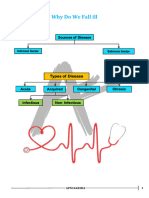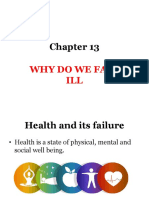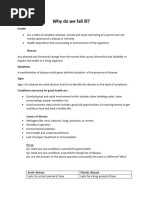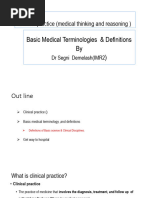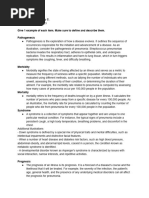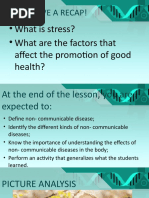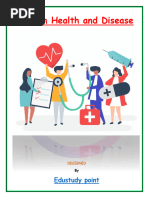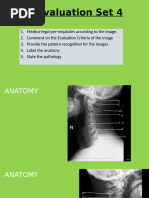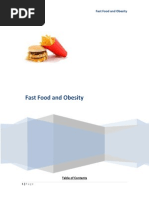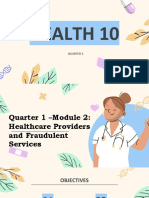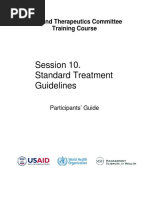PTY Unit 2 Notes
PTY Unit 2 Notes
Uploaded by
rosechicuarimba333Copyright:
Available Formats
PTY Unit 2 Notes
PTY Unit 2 Notes
Uploaded by
rosechicuarimba333Copyright
Available Formats
Share this document
Did you find this document useful?
Is this content inappropriate?
Copyright:
Available Formats
PTY Unit 2 Notes
PTY Unit 2 Notes
Uploaded by
rosechicuarimba333Copyright:
Available Formats
1
LEARNING OBJECTIVES:
❖ PROVIDE A BRIEF DESCRIPTION + CAUSE OF RESPECTIVE DISEASES
❖ CLASSIFY THE DIFFERENT DISEASES + PROVIDE AN EXAMPLE OF EACH
TASK 1: CLASSIFICATION OF DISEASES
• ICD = International Classification of Disease; The ICD provides a method of classifying
diseases, injuries + causes of death
• WHO = World Health organisation -> responsible to direct and lead global health in the
United Nations
COMMUNICABLE VS NON-COMMUNICABLE DISEASES
COMMUNICABLE/INFECTIOUS/TRANSMISSIBLE NON-COMMUNICABLE
• Illness that results from the infection, • Medical condition/disease which is
presence of pathogens non-infectious + cannot be passed
• pass from 1 individual to another from person to person
• Inheritable • Can be heritable
e.g. measles, HIV, STDs, hepatitis e.g. heart disease, stroke, cancer
INTRINSIC VS EXTRINSIC DISEASE
INTRINSIC EXTRINSIC
• Disease causing factors which exist • Disease causing factors which enter
within the human body (act from the human body from outside
within individual)
• Diseases caused by intrinsic factors
-> organic or metabolic disease
i.e organ function, person’s age, co-morbid i.e. environmental, cultural, related to lifestyle
disease Diseases: Malaria, rabies, night blindness
CONGENITAL VS AQUIRED DISEASE
CONGENITAL AQUIRED
• Present at the time of birth • Acquired during the lifetime of an
individual
• Not present @ birth
e.g. down syndrome, cystic fibrosis e.g. influenza, bacterial pneumonia
Notes by Gabriella Adolphe
2
TASK 2: CONGENITAL & AQUIRED
CONGENITAL
1. Genetic factors = caused due to mutations in one/more genes or damage to
chromosomes e.g. Down syndrome
2. Contracted in utero = factors in utero e.g. spina bifida
3. Developmental = e.g. polydactyly, heart defects, limb defects
AQUIRED
1. Traumatic injuries = caused by a wide variety of blunt, penetrating + burn mechanisms
(external forces on the body) e.g. sport injuries, falls, MVAs, natural disasters
2. Infective = caused by the spread/direct transfer of bacteria + viruses (pathogens)
e.g. influenza, measles
3. Neoplastic = conditions that cause tumour growth – both benign + malignant; due to a
pathological process called neoplasia e.g. lymphoma, breast cancer
4. Endocrine = caused by defective functioning of the endocrine glands
e.g. hyperthyroidism + hypothyroidism, type 1 diabetes, dwarfism
5. Metabolic =
• Due to a lack of essential food/nutrints/vitamins
e.g. Rickets -> lack of vitamin D
• Disturbances in the metabolic processes
e.g. Defective removal of uric acid
6. Chemical poisoning = due to entry of chemical poisons into body
e.g. cyanide poisoning, lead, arsenic, insectisides
7. Allergies = a damaging immune response by the body to a substance to which it is
hypersensitive e.g. pollen, hayfever
8. Psychiatric = Due to mental status -> caused by genes, family history, life experiences,
traumatic brain injury
e.g. depression, dementia, bipolar disorder
9. Iatrogenic = adverse effect caused by medical treatment -> side effects of prescribed
medications
e.g. hair loss due to radiation/chemo
10. Idiopathic = arising from an unknown cause e.g. idiopathic scoliosis, essential
hypertension
Notes by Gabriella Adolphe
3
DIAGNOSIS & TREATMENT
THERAPY
▪ Treatment of disease with the aim of :
o Achieving a cure
o Reducing the signs + symptoms to a level where normal function can be
restored
▪ Different types of therapy (Davies: 12-16)
o Medical treatment
o Palliative treatment -> treatment to relieve symptoms, but not curing the cause
o Surgical treatment
o Physiotherapy (work closely with occupational therapists)
o Electrotherapy -> used to maintain active muscle contractions
o Hydrotherapy
o Radiotherapy -> treatment by ionizing radiation
o Psychiatric treatment
DRUGS FOR PREVENTION/TREATMENT
DRUG THERAPY:
Substances that are taken into the body/applied to the body surface (topical) for the
prevention/treatment of a disease or relief of its symptoms
▪ Certain drugs may destroy infecting organisms (e.g. Antibiotics), while certain drugs may
only relieve the symptoms -> the underlying cause is not corrected (e.g.
Anticonvulsants)
TASK 3: FUNCTIONS OF DRUGS
▪ Anaesthetics = produces loss of sensitivity to touch + pain (local) or consciousness
(general) ->prevent pain during surgery + other procedures
▪ Analgesics = relieve pain (headaches, injuries, arthritis)
▪ Antibiotics = treat/prevent some types of bacterial infection
▪ Anticoagulants = prevent + treat existing blood clots (blood thinners)
▪ Antihypertensives = treat high blood pressure -> prevent heart failure, heart
attack/stroke
▪ Antihistamines = block action of histamine responsible for allergic reactions -> treat
symptoms of allergies, may also be used to prevent motion sickness
▪ Laxatives = -> promote bowl movement (increases bulk in stool ) ->treat
constipation
▪ Contrast media = used in radiographic practices to increase the visibility of organs
(soft tissue)
▪ Cytotoxins = destroys malignant cells -> the treatment of cancer to prevent dividing
+ spreading
▪ Diuretics = increase secretion of urine -> help rid your body of sodium + water
▪ Disinfectants = chemicals that destroy pathogens
▪ Hormones = secretions of endocrine glands or chemical substitutes -> used to treat
menopausal symptoms
Notes by Gabriella Adolphe
4
▪ Hypnotics = used to induce & improve the quality of sleep + relieve pain
▪ Sedatives = slow down your brain activity + feel more relaxed; induce sleep -> used
for anxiety disorders, panic disorders, sleep disorders
▪ Steroids = anti-inflammatory drug, treat rheumatologic disease e.g. arthritis,
vasculitis
▪ Tranquilizers =to reduce anxiety, fear, agitation + related states of mental
disturbance
▪ Vaccines and sera = boost the immune system + prevent serious, life-threatening
diseases
Notes by Gabriella Adolphe
You might also like
- Task 5 Banksia-SD-SE-T1-Hazard-Report-Form-Template-V1.0-ID-200278Document5 pagesTask 5 Banksia-SD-SE-T1-Hazard-Report-Form-Template-V1.0-ID-200278Samir Mosquera-Palomino100% (1)
- Ce Elect 1 Sanitary Engineering Disease and ImmunityDocument12 pagesCe Elect 1 Sanitary Engineering Disease and ImmunityRiJade Bibiano100% (3)
- Varma Sara Sookshmam - The Unvieled Secret of "Healing Through Varmam" Free Varma MagazineDocument14 pagesVarma Sara Sookshmam - The Unvieled Secret of "Healing Through Varmam" Free Varma MagazineS Ramesh Babu100% (7)
- Russian Healing BlanketDocument2 pagesRussian Healing BlanketJames MatthewNo ratings yet
- A Level Health and DiseasesDocument32 pagesA Level Health and DiseaseszvichauyakeithtNo ratings yet
- Topic 13 Global Distribution of Diseases My NC Notes 1Document31 pagesTopic 13 Global Distribution of Diseases My NC Notes 1Melogina ManoNo ratings yet
- Medical BiotechnologyDocument135 pagesMedical BiotechnologyrahelNo ratings yet
- Why Do We Fall IllDocument10 pagesWhy Do We Fall IllYash KediaNo ratings yet
- PathophysiologyDocument137 pagesPathophysiologyAhmed S. Hamid0% (1)
- Summer ProjectDocument14 pagesSummer ProjectgabriellegnadNo ratings yet
- CH13 Ninenth Standard NCERT BOOKDocument26 pagesCH13 Ninenth Standard NCERT BOOKPrash ShanthNo ratings yet
- Cause of DiseaseDocument29 pagesCause of DiseaseTariku olanaNo ratings yet
- Causes and Prevention of DiseasesDocument4 pagesCauses and Prevention of DiseasesSusan Hepzi100% (1)
- Why Do We Fall Ill NotesDocument6 pagesWhy Do We Fall Ill NotessrianshNo ratings yet
- Revision - Why Do We Fall Ill NotesDocument15 pagesRevision - Why Do We Fall Ill NotesAtharva VarshneyNo ratings yet
- Introduction To Clinical Practice (Terminology) FINALDocument44 pagesIntroduction To Clinical Practice (Terminology) FINALamarenatanim97No ratings yet
- Unit 1 14.04.20 IIDocument22 pagesUnit 1 14.04.20 IIDeepak GuptaNo ratings yet
- Intro and InflammationDocument7 pagesIntro and InflammationrazondiegoNo ratings yet
- Diseases-Types-and-ClassificationDocument8 pagesDiseases-Types-and-Classificationcheenumeena80No ratings yet
- Hiv/AidsDocument6 pagesHiv/Aidsampogison08No ratings yet
- Human Health and Disease TomDocument19 pagesHuman Health and Disease TomReyneil ElumbaNo ratings yet
- SeatworkDDD JamolinDocument4 pagesSeatworkDDD Jamolinqjamolin210000000237No ratings yet
- 13 QN ANSWRS Why Do We Fall IllDocument3 pages13 QN ANSWRS Why Do We Fall IllceoNo ratings yet
- Class 13. Disease ManagementDocument38 pagesClass 13. Disease Managementsreenu_pesNo ratings yet
- Diseases and ImmunityDocument35 pagesDiseases and ImmunityAbraham Jacob CuNo ratings yet
- Characterization and Classification of DiseaseDocument29 pagesCharacterization and Classification of DiseaseAmirahNo ratings yet
- Why Do We Fall IllDocument6 pagesWhy Do We Fall IllMonika Mehan100% (10)
- Lec 10Document29 pagesLec 10api-27080431No ratings yet
- Why Do We Fall IllDocument15 pagesWhy Do We Fall IllFareedha ZaibaaNo ratings yet
- GR - 9 - Revision Notes - Why We Do Fall IllDocument9 pagesGR - 9 - Revision Notes - Why We Do Fall IllAditi KumariNo ratings yet
- Factors Affecting Mental HealthDocument4 pagesFactors Affecting Mental HealthSamantha CorpuzNo ratings yet
- Immunity 1 NotesDocument43 pagesImmunity 1 NotesParth KulkarniNo ratings yet
- 4TH Quarter in HealthDocument1 page4TH Quarter in HealthAlexis AguilarNo ratings yet
- DiseaseDocument19 pagesDiseaseapi-307430346No ratings yet
- EpidemicDocument60 pagesEpidemickya ho agarNo ratings yet
- RH PATHO2022 - (Chapt 01 - Intro To PathoPhys)Document19 pagesRH PATHO2022 - (Chapt 01 - Intro To PathoPhys)Toka AlzoubiNo ratings yet
- Biology project - By Odeicia and SarahDocument20 pagesBiology project - By Odeicia and Sarahodeicialawrence6No ratings yet
- Health Education BookletDocument18 pagesHealth Education BookletScribdTranslationsNo ratings yet
- Chapter 1 DiseasesDocument10 pagesChapter 1 DiseasesQaran PrintingNo ratings yet
- Disease 1Document18 pagesDisease 1mckarma68No ratings yet
- Why Do We Fall Ill - Part IiDocument12 pagesWhy Do We Fall Ill - Part IiChhaya GuptaNo ratings yet
- HEA 101 Lecture # 2 Section # 2Document33 pagesHEA 101 Lecture # 2 Section # 2mahfuzNo ratings yet
- Seminar On PsychodynamicsDocument15 pagesSeminar On PsychodynamicsHaresh KatkarNo ratings yet
- Chapter One Microorganisms and Humans Form 4 BiologyDocument13 pagesChapter One Microorganisms and Humans Form 4 Biologyayuubkaarlo123No ratings yet
- NSTP-reviewer-for-midtermDocument4 pagesNSTP-reviewer-for-midtermkrisshavinoya7No ratings yet
- Let'S Have A Recap!: - What Is Stress? - What Are The Factors That Affect The Promotion of Good Health?Document27 pagesLet'S Have A Recap!: - What Is Stress? - What Are The Factors That Affect The Promotion of Good Health?Alma Bernadette RuivivarNo ratings yet
- Notes of - Why Do We Fall Ili, 2011-12Document4 pagesNotes of - Why Do We Fall Ili, 2011-12Rahul BhardwajNo ratings yet
- Human Health and Disease (Edustudy Point)Document12 pagesHuman Health and Disease (Edustudy Point)hpal7342No ratings yet
- 3 Communicable and Non Communicable Dissease 29092023 110236pmDocument26 pages3 Communicable and Non Communicable Dissease 29092023 110236pmSajjal ZiaNo ratings yet
- Histopatho Lec - Assignment No. 1Document4 pagesHistopatho Lec - Assignment No. 1Manelli Faten BuenaventuraNo ratings yet
- Health Quarter 4Document1 pageHealth Quarter 4jhoncarl.esmaNo ratings yet
- 9 13+resource+23Document7 pages9 13+resource+23geetasatyapriyaNo ratings yet
- PPDCDocument13 pagesPPDCGAYATHRI100% (1)
- Why Do We Fall Ill - Part IDocument15 pagesWhy Do We Fall Ill - Part IChhaya GuptaNo ratings yet
- Care Is Fetal DevelopmentDocument34 pagesCare Is Fetal DevelopmentRgigiNo ratings yet
- Lesson Note On Basic Science JSS 1 Second TermDocument9 pagesLesson Note On Basic Science JSS 1 Second Termgotegs622No ratings yet
- Midterms - Medical TerminologyDocument28 pagesMidterms - Medical Terminologyhatdog hatdogNo ratings yet
- Diseases, Treatments and RemediesDocument5 pagesDiseases, Treatments and RemediesAndrea FumasoniNo ratings yet
- PSYCHOIMMUNOLOGY PPTDocument39 pagesPSYCHOIMMUNOLOGY PPTPihu SalamNo ratings yet
- Illness (Text)Document2 pagesIllness (Text)Pabliito De Jesús TapiaNo ratings yet
- The Complete Handbook on Meningitis: Prevention, Care, and Recovery: The NeuroHealth Collection: Understanding Diseases of the Nervous System, #8From EverandThe Complete Handbook on Meningitis: Prevention, Care, and Recovery: The NeuroHealth Collection: Understanding Diseases of the Nervous System, #8No ratings yet
- How to Make Disease Disappear: The Effective Guide to Cure and Prevent DiseasesFrom EverandHow to Make Disease Disappear: The Effective Guide to Cure and Prevent DiseasesNo ratings yet
- Encephalitis, A Simple Guide To The Condition, Treatment And Related ConditionsFrom EverandEncephalitis, A Simple Guide To The Condition, Treatment And Related ConditionsRating: 5 out of 5 stars5/5 (17)
- EndNote_download_StaffDocument3 pagesEndNote_download_Staffrosechicuarimba333No ratings yet
- outDocument170 pagesoutrosechicuarimba333No ratings yet
- DHA_81Document30 pagesDHA_81rosechicuarimba333No ratings yet
- unit 4 CT_UJ_LEC1Document55 pagesunit 4 CT_UJ_LEC1rosechicuarimba333No ratings yet
- Film Evaluation Set 4 (1)Document12 pagesFilm Evaluation Set 4 (1)rosechicuarimba333No ratings yet
- unit 5 MRIDocument12 pagesunit 5 MRIrosechicuarimba333No ratings yet
- Film Evaluation Set 5Document8 pagesFilm Evaluation Set 5rosechicuarimba333No ratings yet
- Dcp01y1 Viva Briefing and AllocationsDocument3 pagesDcp01y1 Viva Briefing and Allocationsrosechicuarimba333No ratings yet
- Homeopathic Treatment of Gall Stones: GallstonesDocument2 pagesHomeopathic Treatment of Gall Stones: GallstonesRCNo ratings yet
- Activity 2 Module 3 - Nupc 101Document8 pagesActivity 2 Module 3 - Nupc 101Regine TacubanNo ratings yet
- Historical Foundation of PE and SportsDocument8 pagesHistorical Foundation of PE and SportsRowainneEichstadtBrittinghamSaracenoNo ratings yet
- From Bite To Mind: TMD - A Personal and Literature Review: Carl Molin, LDS, Odont DTDocument11 pagesFrom Bite To Mind: TMD - A Personal and Literature Review: Carl Molin, LDS, Odont DTDrDejanDrakulNo ratings yet
- (Asking-Reporting Health Problem and Diagnosing)Document10 pages(Asking-Reporting Health Problem and Diagnosing)nilanNo ratings yet
- A Critical Analysis of The UGC-approved List of Journals' List of Verified JournalsDocument54 pagesA Critical Analysis of The UGC-approved List of Journals' List of Verified JournalsHimanshu SharmaNo ratings yet
- A Review of Classification of Disease in AyurvedaDocument11 pagesA Review of Classification of Disease in AyurvedaEditor_IAIMNo ratings yet
- Clinical Decision Support SystemsDocument13 pagesClinical Decision Support Systems//VminNo ratings yet
- CHN TP ReviewDocument40 pagesCHN TP ReviewPatrick Jon LumaghanNo ratings yet
- Violent Disease and The True Flesh - Pandemic Delirium and Disease-Derived Subjectivity in Antonin ArtaudDocument11 pagesViolent Disease and The True Flesh - Pandemic Delirium and Disease-Derived Subjectivity in Antonin ArtaudDaniel KongNo ratings yet
- POEA SEC 2010 AmendmentsDocument44 pagesPOEA SEC 2010 AmendmentscesarjruyNo ratings yet
- Ic 57 Real FeelDocument47 pagesIc 57 Real FeelChotu SinhaNo ratings yet
- William Osler El Hombre y Sus DescripcionesDocument10 pagesWilliam Osler El Hombre y Sus Descripcionescristian vallejoNo ratings yet
- Fast Food ProjectDocument13 pagesFast Food ProjectOsama Mohamed100% (1)
- Epidemiologi Gangguan JiwaDocument16 pagesEpidemiologi Gangguan JiwaAbamvc Muhammad AkbarNo ratings yet
- Depression - Dysthymic Disorder by SlidesgoDocument40 pagesDepression - Dysthymic Disorder by SlidesgoJuan GamarraNo ratings yet
- Animal Experimentation ViewpointsDocument80 pagesAnimal Experimentation ViewpointschristianbarrigaNo ratings yet
- Activity Report (Training On HIV Counseling and Testing - June 29 - July 2, 2023)Document6 pagesActivity Report (Training On HIV Counseling and Testing - June 29 - July 2, 2023)Angelica Gementiza0% (1)
- Dictionary of Social WorkDocument40 pagesDictionary of Social Workfranciscogarrido100% (1)
- Takaful Case StudyDocument2 pagesTakaful Case StudyHumaizah MaiNo ratings yet
- Crisis Standards of Care: Crisis Level Guidance For COVID-19Document42 pagesCrisis Standards of Care: Crisis Level Guidance For COVID-19Riley SnyderNo ratings yet
- HealthDocument47 pagesHealthClarence Jayne RoselNo ratings yet
- Geomedicine: A Patient's Geomedicine: A Patient's Perspective PerspectiveDocument33 pagesGeomedicine: A Patient's Geomedicine: A Patient's Perspective PerspectiveNagarajHBNo ratings yet
- The Spiritual Properties of Herbs - GurudasDocument287 pagesThe Spiritual Properties of Herbs - Gurudasjamesfranke1978100% (3)
- 10 PG Standard Treatment Guidelines Final 08Document24 pages10 PG Standard Treatment Guidelines Final 08yosafat mustikoartoNo ratings yet
- Lived Experiences of The Patients Hospitalized With COVID-19: A Phenomenological Study in A Province of Northwest IranDocument14 pagesLived Experiences of The Patients Hospitalized With COVID-19: A Phenomenological Study in A Province of Northwest IranRaymariz DamasoNo ratings yet
- IssueBriefFinalDraft 2023Document19 pagesIssueBriefFinalDraft 2023Shreya RNo ratings yet







